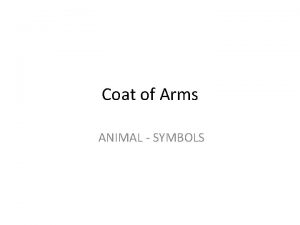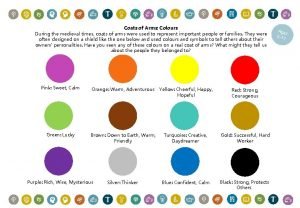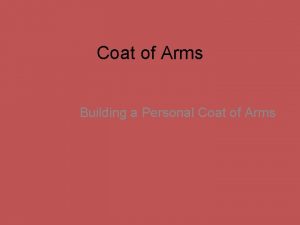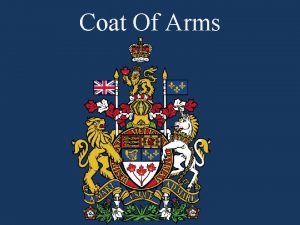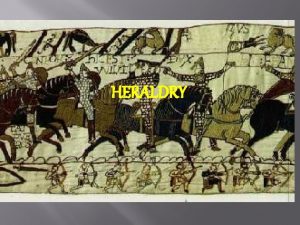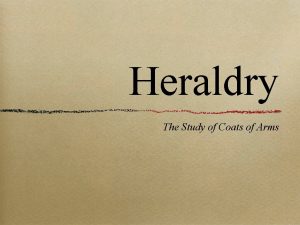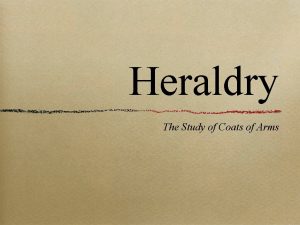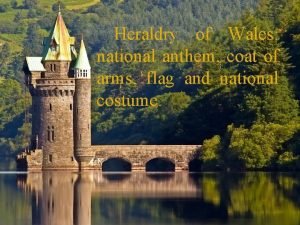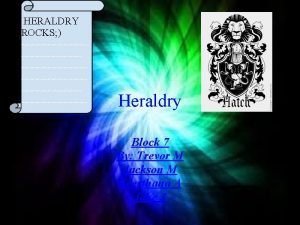Heraldry the Parts of a Coat of Arms










- Slides: 10

Heraldry & the Parts of a Coat of Arms The Meanings Behind the Symbols Sample Crests | Variations for One Name Heraldry Bookstore | Home COLORS Even the colors can have special meaning in a "family crest" or coat of arms: Gold (Or) Generosity and elevation of the mind Silver or White (Argent) Peace and sincerity Red (Gules) Warrior or martyr; Military strength and magnanimity Blue (Azure) Truth and loyalty Green (Vert) Hope, joy, and loyalty in love Black (Sable) Constancy or grief Purple (Purpure) Royal majesty, sovereignty, and justice Orange (Tawny or Tenne) Worthy ambition Maroon (Sanguine or Murray) Patient in battle, and yet victorious

A Brief History of Heraldry has been defined as the art of blazoning, assigning, and marshalling a coat of arms. Its origins are uncertain, but Sir Bernard Burke, Ulster King of Arms, has drawn his own conclusion: “[T]he registry of its birth may be found among the archives of the Holy Wars, . . . its cradle was rocked by the soldiers of the Cross, and. . . its maturity was attained in the chivalrous age of Feudalism. ” Between 1135 and 1155 A. D. , seals show the general adoption of heraldic devices in Europe. Historians once theorized that a coat of arms enabled a knight to be recognized by his followers during battle. The coat of arms became hereditary just as a knight inherited the right to lead or the duty to follow another leader in battle. Later historians dispute this theory based on the small numbers of knights who had any followers. "The service due from a military tenant in the feudal system was well-defined. He held his land by service of two knights, one knight, or half a knight, . . A single knight, let alone a fraction of a knight, had no band of followers, so he had no need to identify himself to them. " [Source: The Oxford Guide to Heraldry by Thomas Woodcock and John Martin Robinson (Oxford University Press, 1988)] Woodcock and Robinson suggest that it was much more likely that the depiction of arms on a shield was a form of "individual vanity" rather than a practical military device. One historian (Beryl Platts, author of Origins of Heraldry) notes that "family identification" was practiced in northern Europe even before the Norman Conquest, and she believes that all heraldry in England is the derivation of the heraldic devices brought by the families who accompanied William the Conqueror. The oldest documented example of a coat of arms borne on a shield is where King Henry I of England is said to have bestowed on his son-in-law, Geoffrey Plantagenet, Count of Anjou, in 1127 A. D. : the azure shield bore four gold lions rampant. [Source: The Oxford Guide to Heraldry by Thomas Woodcock and John Martin Robinson. ] Regardless of their origins, coats of arms became military status symbols, and their popularity increased along with the popularity of the tournament, which was developed in the mid-eleventh century in France (reportedly by Godfrey de Preuilly). The tournament became a training ground for knights, and its pageantry became more elaborate as time passed. Some knights made their living (and their reputations) roaming from tournament to tournament. William the Marshal and Roger de Gaugi were two such enterprising men, not only excelling at tournaments but extorting ransoms from the families of knights they captured. By 1400 A. D. , bearing a coat of arms had become a prerequisite to participation in a tournament, and due to the importance of social standing in such pageants, a coat of arms also became a mark of noble status. In the early days, most coats of arms were assumed by the bearers and not "granted" by any authority. King Richard I changed his coat of arms from two lions combatant (or a lion rampant) to three gold leopards (or lions passant guardant). The earliest coats of arms were fairly simple -- bars or wavy lines, a lion rampant or an eagle displayed, or an arrangement of fleurs-de-lis. The designs became more complex as the years passed, and the practice of quartering (incorporating the arms of other families acquired through marriages) developed. The word “Heraldry” is derived from the German “heer” -- a host, an army -- and “held” -- a champion. The term “blason, ” by which the science of heraldry is denoted in French, English, Italian, and German, is probably derived from the German word “blazen” -- to blow the horn. Whenever a new Knight appeared at a Tournament, the herald sounded the trumpet, and as the competitors attended with closed visors, it was his duty to explain the bearing of the shield or coat-armour belonging to each. This knowledge of the various devices and symbols was called Heraldry, and as the announcement was accompanied with the sound of a trumpet, it was termed “blazoning the arms. ” Source: Burke, Bernard, The General Armory of England, Scotland, Ireland, and Wales (Heritage Books, Inc. , 1996).

Shields: There is some debate as to the meaning of the shape of the shield. Most historians agree that the shape was usually determined by the time period and geographic region. The shape is not a part of the official blazon, so modern heraldry artists choose shapes to suit the design. Some of the most commonly used designs are shown here.






Marks of Cadency Also known as "Differences" Used to indicate the various sons in a family, i. e. , the eldest son during the lifetime of his father bears a "Label" on his coat of arms.

There is significantly more to the design and understanding of the shield and even more to the crests themselves. Should you want to have your students design shields themselves then be prepared to consider just how much information you want to provide them and to what degree do you want them to be historically correct. You may want to modify the shields to have them do ones that reflect the same influences but with a more modern take on some of the aspects of the shields themselves. As such you may want to let them substitute their own items for some of the multitude of items that can be placed on a shield. But be prepared to check for such things as gang symbols, and other non-school appropriate items snuck into the designs. Remember that in the end it’s about what they can learn from the design process and the understanding of heraldry. Here’s the web site…. http: //www. fleurdelis. com/crest. htm
